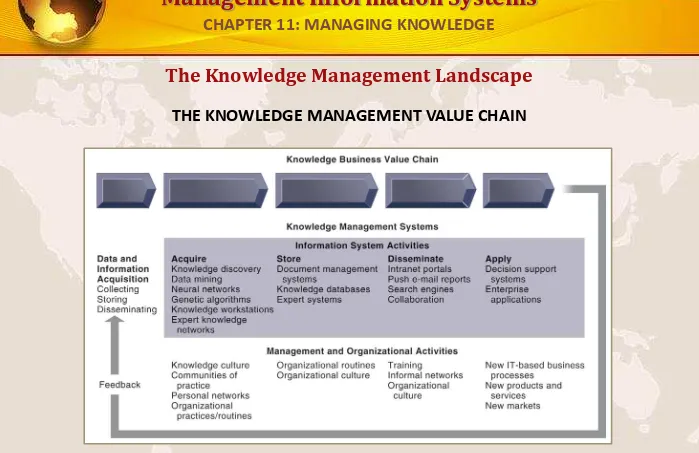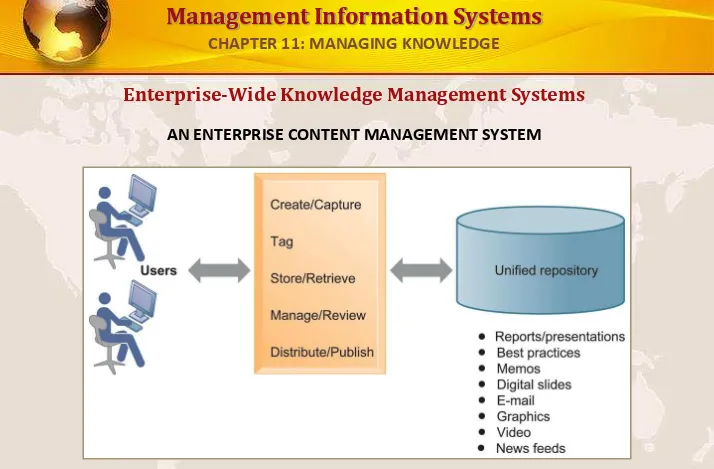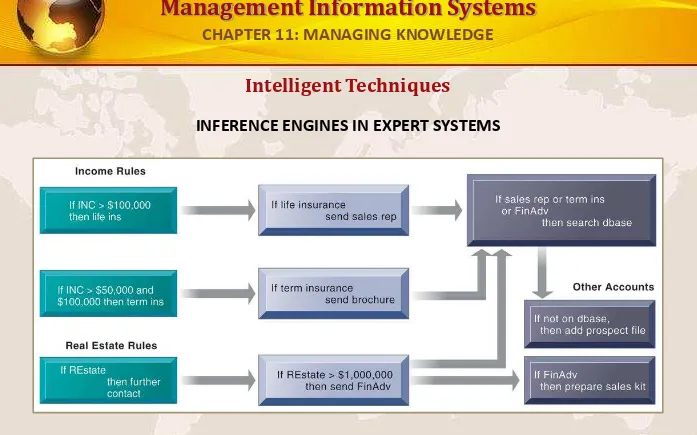Management Information Systems
MANAGING THE DIGITAL FIRM, 12THEDITION
MANAGING KNOWLEDGE
Chapter 11
VIDEO CASES
Management Information Systems
•
Apa peran program manajemen pengetahuan dan
manajemen pengetahuan dalam bisnis?
•
Apa jenis sistem yang digunakan untuk manajemen
pengetahuan seluruh perusahaan dan bagaimana
mereka memberikan nilai bagi bisnis?
•
Apa saja jenis utama dari sistem kerja pengetahuan
dan bagaimana mereka memberikan nilai bagi
perusahaan?
•
Apa manfaat bisnis menggunakan teknik cerdas
untuk manajemen pengetahuan?
Learning Objectives
Management Information Systems
• Problem: Penelitian Dokumen-intensif dan bergantung pada kertas catatan perkembangan
• Solutions: Manajemen dokumen menyimpan informasi sistem penelitian elektronik digital
• eLab Notebook documentum management software
menciptakan PDF, memungkinkan tanda tangan digital, embeds hak penggunaan, memungkinkan pencarian digital perpustakaan
• Menunjukkan TI berperan dalam mengurangi biaya dengan membuat pengetahuan organisasi lebih mudah tersedia
• Menggambarkan bagaimana suatu organisasi dapat menjadi lebih efisien dan menguntungkan melalui content
management
P&G Moves from Paper to Pixels for Knowledge Management
CHAPTER 11: MANAGING KNOWLEDGE
Management Information Systems
• Sistem manajemen pengetahuan antar wilayah yang paling cepat berkembang dari investasi perangkat lunak
• Information economy
– 55% angkatan kerja AS: pengetahuan dan informasi pekerja
– 60% Gross domestic product -GDP AS dari sektor pengetahuan dan informasi
• Substansial bagian dari nilai pasar saham perusahaan terkait dengan aset tidak berwujud: pengetahuan, merek, reputasi, dan proses bisnis yang unik
• Proyek berbasis pengetahuan dilaksanakan dengan baik dapat menghasilkan ROI yang luar biasa
Pemandangan Manajemen Pengetahuan
Management Information Systems
• Dimensi penting dari pengetahuan
– Pengetahuan adalah aset perusahaan
• intangible
• Penciptaan pengetahuan dari data, informasi, membutuhkan sumber daya organisasi
• Seperti hal itu dibagikan, mengalami efek jaringan
– Pengetahuan memiliki bentuk yang berbeda
• Mungkin eksplisit (didokumentasikan) atau tacit (berada dalam pikiran)
• Tahu-bagaimana, kerajinan, keterampilan
• Cara mengikuti prosedur
• Mengetahui mengapa sesuatu terjadi (kausalitas)
The Knowledge Management Landscape
Management Information Systems
•
Dimensi penting dari pengetahuan (cont.)
–
Pengetahuan memiliki lokasi
• acara kognitif
• Baik sosial dan individu
• "Sticky" (sulit untuk bergerak), terletak (terjerat dalam budaya perusahaan), kontekstual (bekerja hanya dalam situasi tertentu)
–
Pengetahuan adalah situasional
• Conditional: Mengetahui kapan harus menerapkan prosedur
• Kontekstual: Mengetahui keadaan untuk menggunakan alat tertentu
The Knowledge Management Landscape
Management Information Systems
•
To transform information into knowledge, firm must
expend additional resources to discover patterns,
rules, and contexts where knowledge works
•
Wisdom:
– Collective and individual experience of applying knowledge to solve problems
– Involves where, when, and how to apply knowledge
•
Knowing how to do things effectively and efficiently
in ways others cannot duplicate is prime source of
profit and competitive advantage
– E.g., Having a unique build-to-order production system
The Knowledge Management Landscape
Management Information Systems
•
Organizational learning
–
Process in which organizations learn
•
Gain experience through collection of
data, measurement, trial and error, and
feedback
•
Adjust behavior to reflect experience
–
Create new business processes
–
Change patterns of management decision
making
The Knowledge Management Landscape
Management Information Systems
•
Knowledge management: Set of business processes
developed in an organization to create, store,
transfer, and apply knowledge
•
Knowledge management value chain:
–
Each stage adds value to raw data and information as
they are transformed into usable knowledge
1. Knowledge acquisition
2. Knowledge storage
3. Knowledge dissemination
4. Knowledge application
The Knowledge Management Landscape
Management Information Systems
•
Knowledge management value chain
1. Knowledge acquisition
•
Documenting tacit and explicit knowledge
– Storing documents, reports, presentations, best practices
– Unstructured documents (e.g., e-mails)
– Developing online expert networks
•
Creating knowledge
•
Tracking data from TPS and external sources
The Knowledge Management Landscape
Management Information Systems
•
Knowledge management value chain (cont.)
2. Knowledge storage
•
Databases
•
Document management systems
•
Role of management:
– Support development of planned knowledge storage systems
– Encourage development of corporate-wide schemas for indexing documents
– Reward employees for taking time to update and store documents properly
The Knowledge Management Landscape
Management Information Systems
•
Knowledge management value chain (cont.)
3. Knowledge dissemination
•
Portals
•
Push e-mail reports
•
Search engines
•
Collaboration tools
•
A deluge of information?
– Training programs, informal networks, and shared management experience help managers focus
attention on important information
The Knowledge Management Landscape
Management Information Systems
•
Knowledge management value chain (cont.)
4. Knowledge application
•
To provide return on investment, organizational
knowledge must become systematic part of
management decision making and become
situated in decision-support systems
– New business practices
– New products and services
– New markets
The Knowledge Management Landscape
Management Information Systems
The Knowledge Management Landscape
THE KNOWLEDGE MANAGEMENT VALUE CHAIN
Knowledge management today involves both information systems activities and a host of enabling management and organizational activities.
FIGURE 11-1
Management Information Systems
•
New organizational roles and responsibilities
–
Chief knowledge officer executives
–
Dedicated staff / knowledge managers
–
Communities of practice (COPs)
• Informal social networks of professionals and
employees within and outside firm who have similar work-related activities and interests
• Activities include education, online newsletters, sharing experiences and techniques
• Facilitate reuse of knowledge, discussion
• Reduce learning curves of new employees
The Knowledge Management Landscape
Management Information Systems
•
3 major types of knowledge management systems:
1. Enterprise-wide knowledge management systems
• General-purpose firm-wide efforts to collect, store, distribute, and apply digital content and knowledge
2. Knowledge work systems (KWS)
• Specialized systems built for engineers, scientists, other knowledge workers charged with discovering and
creating new knowledge
3. Intelligent techniques
• Diverse group of techniques such as data mining used for various goals: discovering knowledge, distilling
knowledge, discovering optimal solutions
The Knowledge Management Landscape
Management Information Systems
The Knowledge Management Landscape
MAJOR TYPES OF KNOWLEDGE MANAGEMENT SYSTEMS
There are three major categories of knowledge management systems, and each can be broken down further into more specialized types of knowledge management systems.
FIGURE 11-2
Management Information Systems
•
Three major types of knowledge in enterprise
1. Structured documents
• Reports, presentations
• Formal rules
2. Semistructured documents
• E-mails, videos
3. Unstructured, tacit knowledge
•
80% of a orga izatio ’s usi ess o te t is
semistructured or unstructured
Enterprise-Wide Knowledge Management Systems
Management Information Systems
•
Enterprise content management systems
–
Help capture, store, retrieve, distribute,
preserve
•
Documents, reports, best practices
•
Semistructured knowledge (e-mails)
–
Bring in external sources
•
News feeds, research
–
Tools for communication and collaboration
Enterprise-Wide Knowledge Management Systems
Management Information Systems
Enterprise-Wide Knowledge Management Systems
AN ENTERPRISE CONTENT MANAGEMENT SYSTEM
An enterprise content management system has capabilities for classifying, organizing, and managing structured and semistructured knowledge and making it available throughout the enterprise.
FIGURE 11-3
Management Information Systems
•
Enterprise content management systems
–
Key problem
–
Developing taxonomy
•
Knowledge objects must be tagged with
categories for retrieval
–
Digital asset management systems
•
Specialized content management systems for
classifying, storing, managing unstructured
digital data
•
Photographs, graphics, video, audio
Enterprise-Wide Knowledge Management Systems
Management Information Systems
•
Knowledge network systems
–
Provide online directory of corporate experts in
well-defined knowledge domains
–
Use communication technologies to make it easy
for employees to find appropriate expert in a
company
–
May systematize solutions developed by experts
and store them in knowledge database
•
Best-practices
•
Frequently asked questions (FAQ) repository
Enterprise-Wide Knowledge Management Systems
Management Information Systems
Enterprise-Wide Knowledge Management Systems
AN ENTERPRISE KNOWLEDGE
NETWORK SYSTEM
A knowledge network maintains a database of firm experts, as well as accepted solutions to known problems, and then facilitates the communication between employees looking for
knowledge and experts who have that knowledge. Solutions created in this communication are then added to a database of solutions in the form of FAQs, best practices, or other documents.
FIGURE 11-4
Management Information Systems
•
Portal and collaboration technologies
–
Enterprise knowledge portals: Access to external
and internal information
• News feeds, research
• Capabilities for e-mail, chat, videoconferencing, discussion
–
Use of consumer Web technologies
• Blogs
• Wikis
• Social bookmarking
Enterprise-Wide Knowledge Management Systems
Management Information Systems
•
Learning management systems
–
Provide tools for management, delivery, tracking,
and assessment of various types of employee
learning and training
–
Support multiple modes of learning
• CD-ROM, Web-based classes, online forums, live instruction, etc.
–
Automates selection and administration of courses
–
Assembles and delivers learning content
–
Measures learning effectiveness
Enterprise-Wide Knowledge Management Systems
Management Information Systems
•
Knowledge work systems
– Systems for knowledge workers to help create new
knowledge and integrate that knowledge into business
•
Knowledge workers
– Researchers, designers, architects, scientists, engineers
who create knowledge for the organization
– Three key roles:
1. Keeping organization current in knowledge
2. Serving as internal consultants regarding their areas of expertise
3. Acting as change agents, evaluating, initiating, and promoting change projects
Knowledge Work Systems
Management Information Systems
•
Requirements of knowledge work systems
–
Substantial computing power for graphics,
complex calculations
–
Powerful graphics and analytical tools
–
Communications and document management
–
Access to external databases
–
User-friendly interfaces
–
Optimized for tasks to be performed (design
engineering, financial analysis)
Knowledge Work Systems
Management Information Systems
Knowledge Work Systems
REQUIREMENTS OF KNOWLEDGE WORK SYSTEMS
Knowledge work systems require strong links to external knowledge bases in addition to specialized hardware and software.
FIGURE 11-5
Management Information Systems
•
Examples of knowledge work systems
–
CAD (computer-aided design):
• Creation of engineering or architectural designs
–
Virtual reality systems:
• Simulate real-life environments
• 3-D medical modeling for surgeons
• Augmented reality (AR) systems
• VRML
–
Investment workstations:
• Streamline investment process and consolidate
internal, external data for brokers, traders, portfolio managers
Knowledge Work Systems
Management Information Systems
Read the Interactive Session and discuss the following questions
•
What is the difference between virtual reality and
augmented reality?
•
Why is augmented reality so appealing to
marketers?
•
What makes augmented reality useful for real
estate shopping applications?
•
Suggest some other knowledge work applications
for augmented reality
Knowledge Work Systems
AUGMENTED REALITY: REALITY GETS BETTER
Management Information Systems
•
Intelligent techniques:
Used to capture individual
and collective knowledge and to extend knowledge
base
– To capture tacit knowledge: Expert systems, case-based
reasoning, fuzzy logic
– Knowledge discovery: Neural networks and data mining
– Generating solutions to complex problems: Genetic
algorithms
– Automating tasks: Intelligent agents
•
Artificial intelligence (AI) technology:
– Computer-based systems that emulate human behavior
Intelligent Techniques
Management Information Systems
•
Expert systems:
–
Capture tacit knowledge in very specific and limited
domain of human expertise
–
Capture knowledge of skilled employees as set of
rules in software system that can be used by others
in organization
–
Typically perform limited tasks that may take a few
minutes or hours, e.g.:
• Diagnosing malfunctioning machine
• Determining whether to grant credit for loan
–
Used for discrete, highly structured decision-making
Intelligent Techniques
Management Information Systems
Intelligent Techniques
RULES IN AN EXPERT SYSTEM
An expert system contains a number of rules to be followed. The rules are interconnected; the number of outcomes is known in advance and is limited; there are multiple paths to the same
[image:33.720.96.705.9.524.2]outcome; and the system can consider multiple rules at a single time. The rules illustrated are for simple credit-granting expert systems.
FIGURE 11-6
Management Information Systems
•
How expert systems work
–
Knowledge base: Set of hundreds or thousands of
rules
–
Inference engine: Strategy used to search knowledge
base
• Forward chaining: Inference engine begins with
information entered by user and searches knowledge base to arrive at conclusion
• Backward chaining: Begins with hypothesis and asks
user questions until hypothesis is confirmed or disproved
Intelligent Techniques
Management Information Systems
Intelligent Techniques
INFERENCE ENGINES IN EXPERT SYSTEMS
[image:35.720.12.709.15.450.2]A i fere e e gi e works sear hi g through the rules a d firi g those rules that are triggered fa ts gathered and entered by the user. Basically, a collection of rules is similar to a series of nested IF statements in a traditional software program; however, the magnitude of the statements and degree of nesting are much greater in an expert system.
FIGURE 11-7
Management Information Systems
•
Successful expert systems
– Con-Way Transportation built expert system to automate and optimize planning of overnight shipment routes for nationwide freight-trucking business
•
Most expert systems deal with problems of
classification
– Have relatively few alternative outcomes
– Possible outcomes are known in advance
•
Many expert systems require large, lengthy, and
expensive development and maintenance efforts
– Hiring or training more experts may be less expensive
Intelligent Techniques
Management Information Systems
•
Case-based reasoning (CBR)
– Descriptions of past experiences of human specialists (cases), stored in knowledge base
– System searches for cases with problem characteristics similar to new one, finds closest fit, and applies solutions of old case to new case
– Successful and unsuccessful applications are grouped with case
– Stores organizational intelligence: Knowledge base is continuously expanded and refined by users
– CBR found in
• Medical diagnostic systems
• Customer support
Intelligent Techniques
Management Information Systems
Intelligent Techniques
HOW CASE-BASED REASONING WORKS
[image:38.720.31.718.6.515.2]Case-based reasoning represents knowledge as a database of past cases and their solutions. The system uses a six-step process to generate solutions to new problems encountered by the user.
FIGURE 11-8
Management Information Systems
•
Fuzzy logic systems
– Rule-based technology that represents imprecision used
i li guisti ategories e.g., old, ool that represe t
range of values
– Describe a particular phenomenon or process
linguistically and then represent that description in a small number of flexible rules
– Provides solutions to problems requiring expertise that is
difficult to represent with IF-THEN rules
• Autofocus in cameras
• Detecting possible medical fraud
• “e dai’s su wa s ste a eleratio o trols
Intelligent Techniques
Management Information Systems
Intelligent Techniques
FUZZY LOGIC FOR TEMPERATURE CONTROL
[image:40.720.14.705.20.447.2]The membership functions for the input called temperature are in the logic of the thermostat to control the room temperature. Membership functions help translate linguistic expressions such as warm into numbers that the computer can manipulate.
FIGURE 11-9
Management Information Systems
•
Neural networks
– Find patterns and relationships in massive amounts of data too complicated for humans to analyze
– Lear patter s y sear hi g for relatio ships, uildi g
models, and correcting over and over again
– Hu a s trai etwork y feedi g it data i puts for whi h
outputs are known, to help neural network learn solution by example
– Used in medicine, science, and business for problems in
pattern classification, prediction, financial analysis, and control and optimization
– Machine learning: Related AI technology allowing computers to learn by extracting information using computation and statistical methods
Intelligent Techniques
Management Information Systems
Read the Interactive Session and discuss the following questions
•
Describe the conditions that preceded the flash
crash.
•
What are some of the benefits of electronic
trading?
•
What features of electronic trading and automated
trading programs contributed to the crash?
•
Could this crash have been prevented? Why or why
not?
Intelligent Techniques
THE FLASH CRASH: MACHINES GONE WILD?
Management Information Systems
Intelligent Techniques
HOW A NEURAL NETWORK WORKS
[image:43.720.22.701.6.465.2]A eural etwork uses rules it lear s fro patter s i data to o stru t a hidde la er of logi . The hidde layer then processes inputs, classifying them based on the experience of the model. In this example, the neural network has been trained to distinguish between valid and fraudulent credit card purchases
FIGURE 11-10
Management Information Systems
•
Genetic algorithms
– Useful for finding optimal solution for specific problem by
examining very large number of possible solutions for that problem
– Conceptually based on process of evolution
• Search among solution variables by changing and
reorganizing component parts using processes such as inheritance, mutation, and selection
– Used in optimization problems (minimization of costs,
efficient scheduling, optimal jet engine design) in which hundreds or thousands of variables exist
– Able to evaluate many solution alternatives quickly
Intelligent Techniques
Management Information Systems
Intelligent Techniques
THE COMPONENTS OF A GENETIC ALGORITHM
[image:45.720.3.720.15.467.2]This e a ple illustrates a i itial populatio of hro oso es, ea h represe ti g a differe t solutio . The genetic algorithm uses an iterative process to refine the initial solutions so that the better ones, those with the higher fitness, are more likely to emerge as the best solution.
FIGURE 11-11
Management Information Systems
•
Hybrid AI systems
–
Genetic algorithms, fuzzy logic, neural
networks, and expert systems integrated
into single application to take advantage
of best features of each
–
E.g., Matsushita eurofuzzy washi g
machine that combines fuzzy logic with
neural networks
Intelligent Techniques
Management Information Systems
•
Intelligent agents
–
Work in background to carry out specific, repetitive,
and predictable tasks for user, process, or application
–
Use limited built-in or learned knowledge base to
a o plish tasks or ake de isio s o user’s ehalf
• Deleting junk e-mail
• Finding cheapest airfare
–
Agent-based modeling applications:
• Systems of autonomous agents
• Model behavior of consumers, stock markets, and supply chains; used to predict spread of epidemics
Intelligent Techniques
Management Information Systems
Intelligent Techniques
INTELLIGENT AGENT“ IN P&G’“ “UPPLY CHAIN NETWORK
[image:48.720.7.719.10.481.2]Intelligent agents are helping P&G shorten the replenishment cycles for products, such as a box of Tide.
FIGURE 11-12
Management Information Systems
All rights reserved. No part of this publication may be reproduced, stored in a retrieval system, or transmitted, in any form or by any means, electronic, mechanical, photocopying, recording, or otherwise, without the
prior written permission of the publisher.
Printed in the United States of America.
Copyright © 2011 Pearson Education, Inc. Publishing as Prentice Hall









